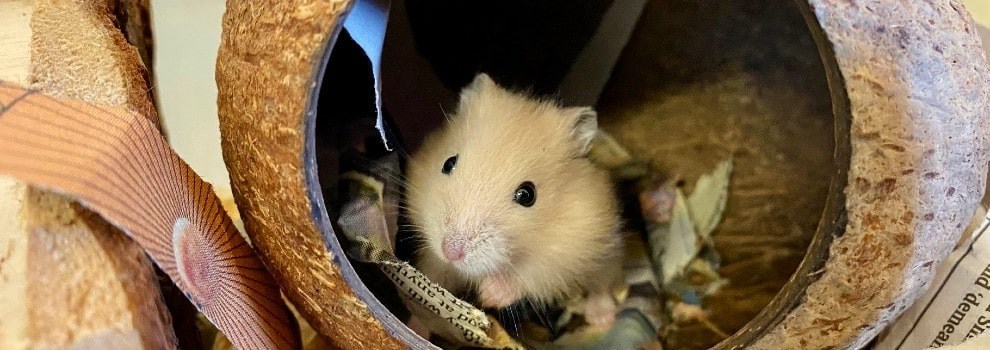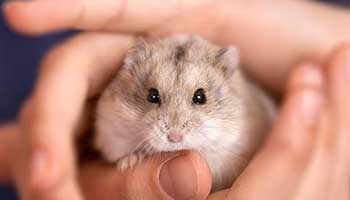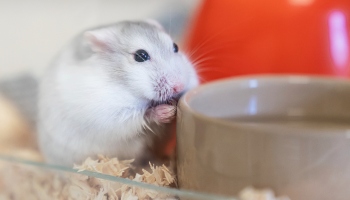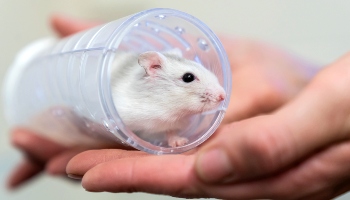Here's what your hamster needs for a comfortable home:
- A comfortable, dry, clean place to live, in a quiet place where they can rest undisturbed.
- No draughts or damp - make sure they aren't exposed to draughty or damp conditions. In the wild, hamsters live in warm, dry climates.
- Predictable light - hamsters need to be kept in a room where the lights go off at more or less the same time each night. Try to avoid erratic hours of lighting. Hamsters are also sensitive to bright sunlight.
- No ultrasound - hamsters should be housed away from household objects that can generate ultrasound, such as televisions, computer screens, vacuum cleaners or sources of running water. Hamsters are very sensitive to high-frequency sounds that we can't hear, and they can find this stressful.
- Appropriate bedding and nesting material.
- A suitable home cage - wild hamsters live in deep burrows and naturally build nests. They quickly dig burrows and can escape easily from poorly constructed cages.
- Places to hide.
- Clean and dry cage - clean their cage regularly, and make sure they have dry bedding and nesting material.
Hamster home-cages
Always provide your hamster with a suitable home-cage which allows for a thick layer of appropriate bedding and nesting material. The cage should be safe from hazards and secure. Plastic cages are better than metal, but wooden cages shouldn’t be used. A cage with stainless steel bars or mesh sides is preferable to one with solid sides, and it should have a raised lid.
The cage floor should be solid to allow for bedding material to be provided, to absorb the relatively small quantities of urine hamsters produce. Avoid wire mesh floors as they can lead to foot problems. The bedding material should also be deep enough to allow your hamsters to dig. If possible also provide your hamsters with an area of litter that is deep enough to allow them to burrow:
- Coarse sand is a natural substrate but is difficult to handle.
- Peat would be suitable but discolours the animal’s coat.
- Dust-free wood shavings or granulated corn-cob, free of preservatives or other chemicals are a good compromise.
Provide your hamsters with appropriate nesting material:
- Suitable materials are good-quality hay, wood wool, shredded paper or cardboard.
Don’t use nesting materials that can separate into thin strands such as cotton wool or similar ‘fluffy’ bedding products, as they pose a serious risk to the health and welfare of your pet – there is concern that this material can cause harm if eaten. Furthermore, the thin strands that form in this material can be difficult to break, potentially leading to a hamster becoming tangled up in their bedding and/or the loss of circulation in tangled limbs resulting in amputation or, unfortunately, euthanasia.
Shelters
Always provide your hamster with a suitable place to hide. For hamsters housed in pairs the number of hiding spaces should exceed the number of animals by one.
In addition, provide a nesting box which is sufficiently large for your hamsters to set up a larder, to sleep and to comfortably move around. This shelter should be dark inside – some have an entrance via an angled tube to prevent light entering it. Hamsters like their nesting box to be placed near food and nesting material, but it should be placed away from water to avoid flooding if the water bottle leaks.
It's best if the nesting box doesn't have a floor, so you can check on your hamsters just by lifting it.
Cage cleaning
Make sure your hamsters’ cage is clean with dry bedding and nesting material. It’s important to maintain a balance between good health and avoiding excessive disturbance and stress.
How often your hamsters cage requires cleaning will depend on the cage size and whether the hamsters use a specific area to toilet. In most cases a deep clean once or twice a month should be sufficient. However, spot cleaning to remove any soiled bedding, uneaten food and faeces every few days is advisable as it will help you keep the cage clean.
Clean out the cage when your hamsters are awake and not in the middle of the day, when they are sleeping, as this disturbance can be stressful for them.
Don’t allow the bedding material to become damp or smelly. Sense of smell is very important to hamsters, so transfer a small amount of old unsoiled bedding and nesting material when you clean out your hamsters’ cage, especially if they are housed in groups. Clean or replace objects soiled by faeces, etc, as these odours may trigger fighting.




